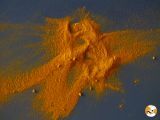The trick you didn't know: how to organize your spices using the color-coded caps

Turmeric, saffron, ginger, pepper... spices have the power to transform a simple dish into something unforgettable. Used in sweet recipes as well as in cocktails or savory dishes, these seasonings are indispensable in any kitchen. Surely it has happened to you more than once: you are cooking, you are looking for a particular spice and, after rummaging through the pile of jars in the pantry, you finally find it. Don't worry, it's happened to all of us!
Today we share with you a trick that will probably help you solve this problem. Did you know that the caps of spice jars follow a color code so you can organize them and find them more easily?
Although it is not a universal code and may vary by brand, in general spice manufacturers follow common guidelines to help consumers quickly identify the type of product they need. Knowing this visual labeling system is very useful, as it makes it easier to identify spices both in the supermarket and at home, especially when you have them stored in drawers or on shelves where you only see the top of the jar.
Here's how to identify spices by the color of the caps, without having to read the entire label. This trick is especially handy for more efficient cooking and organization.
The color code that will help you organize your spices is this:
1. Reds and Oranges: Ground spices and hot spices
Red or orange caps are usually used for spices that come from dried seeds, fruits or roots and are already ground, ready for use in cooking. For example: paprika, cayenne, cinnamon or cumin. These ingredients, with intense colors by nature, are visually associated with reddish, orange or brown tones, which reinforces this identification.
Some brands reserve this intense red color for their hot spices: cayenne, piripiri, etc.
2. Brown or orange tones: Whole spices
Brown or orange caps identify whole spices, such as cloves or nutmeg. These spices usually need to be grated, crushed or ground just before use. They are also used in slow-cooked stews, where they release their full flavor without the need for pre-grinding.
3. Green: Dried Herbs and Organic Herbs
Green is generally reserved for dried herbs such as oregano, thyme, basil, rosemary, anise or coriander. Green caps evoke the natural color of the dried leaves of these plants, making them easy to identify. In addition, this color suggests freshness and naturalness, characteristics that are associated with these herbs.
In many supermarkets, green also indicates that the spices are of organic origin.
4. Orange or blue/purple: Spice mix.
These colors are often used for spice blends such as garam masala, ras el hanout, persillade, or specific preparations for paellas, barbecues or tacos. They are also used for seasonings such as specific seasonings for chicken or fish. The color highlights that these are complex combinations, with several ingredients in a single jar.
5. Yellow: Exotic spices
Yellow, although less frequent, is used for exotic or rare spices such as saffron or turmeric. This color reinforces the visual image of these golden spices, prized both for their flavor and their medicinal properties.
6. Gray, white or black: Basic products
Essential spices or condiments in the kitchen, such as salt, pepper or garlic powder, are usually capped in neutral colors: white, black or gray. These tones reinforce the idea that these are everyday products and essential in any kitchen.
>>> Although not all brands follow exactly the same color scheme, the patterns we have mentioned are quite common and will help you have a more organized, efficient and pleasant cooking experience.




Comments